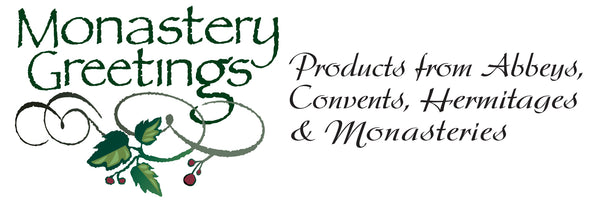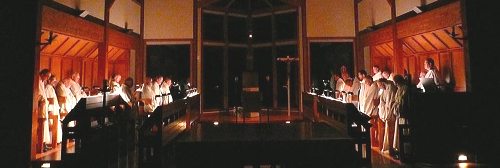Story & Vision
In 1997, founder Will Keller wrote nearly 350 monasteries and religious communities in the United States and Canada and asked them about products they make and sell to the public. During this research, he discovered that, while these community businesses have numerous high-quality products, often they do not have the time or resources to reach a wide audience. Hence, the concept of Monastery Greetings was born and tailored to meet their marketing needs.
Monastery Greetings was the only printed catalog and website in the USA that sells only products from monasteries, convents, abbeys and hermitages. The first catalog was launched on a small scale in the fall of 1999. In 2002, we were honored by the monks of St. Joseph's Abbey in Spencer, Massachusetts when they asked Monastery Greetings to handle retail mail order fulfillment of Trappist Preserves (an award-winning product line that includes 30 preserves, jellies, conserves and marmalade and is the largest monastic business in the United States.) In 2010, Monastery Greetings was licensed to sell beer and now sells a wide variety of Trappist ales and other monastic brews through the mail.
Today, Monastery Greetings works with about 75 monasteries and occupies 8,000 square feet in a reclaimed factory space (a former torpedo factory!) which houses its phone center and offices, shipping and receiving and inventory. This single location provides customers and monastic suppliers with superior and prompt service. In 2019, Monastery Greetings ceased producing printed catalogs and is now completely online. MonasteryGreetings.com has a core of about 500 products and is always looking to add new items.
In addition to acting as the retail mail order department for several communities, Monastery Greetings has become a place where monastic businesses can share ideas about new products. With more than 20 years of experience, Monastery Greetings can help evaluate them and, ultimately, bring them to market.
Abbeys that sell products through Monastery Greetings
Abbey of Our Lady of Guadalupe: Lafayette, Oregon
Assumption Abbey: Ava, Missouri
Conception Abbey: Conception, Missouri
Heiligenkreuz Abbey: Heiligenkreuz, Austria
Holy Cross Abbey: Berryville, Virginia
Mount St. Mary's Abbey: Wrentham, Massachusetts
Our Lady of Consolation Priory, Amity, Oregon
Our Lady of the Mississippi Abbey: Dubuque, Iowa
St. John's Abbey: Collegeville, Minnesota
St. Joseph's Abbey: Spencer, Massachusetts
Tautra Mariakloster: Tautra, Norway
What is an Abbey?
An abbey (from Latin abbatia, derived from Syriac abba, "father"), is a Christian monastery or convent, under the government of an Abbot or an Abbess, who serves as the spiritual father or mother of the community. According to the Catholic Encyclopedia, an abbey is a "monastery canonically erected and autonomous, with a community of not fewer than twelve religious; monks under the government of an abbot; nuns under that of an abbess." An autonomous priory is ruled by a superior who bears the title of prior instead of that of abbot; but this distinction was unknown in the first centuries of monastic history. Such were the twelve great cathedral priories of England, immediately governed by a prior, the diocesan being considered the abbot. Other priories were founded as cells, or offshoots from the great abbeys, and remained dependent on the parent house, by whose abbot the prior was appointed, and was removable at will. Originally the term monastery designated, both in the East and in the West, the dwelling either of a solitary or of a community; while caenobium, congregatio, fraternitas, asceterion, etc. were applied solely to the houses of communities.
Convents that sell products through Monastery Greetings
Benedictines of Mary, Queen of Apostles: Gower, Missouri
Sisters of St. Benedict, Clyde, Missouri
Ursuline Sisters, Cleveland, Ohio
What is a Convent?
A convent (Latin conventus, originally signifying an assembly of Roman citizens in the provinces for purposes of administration and justice) is either a community of priests, religious brothers, religious sisters, or nuns, or the building used by the community, particularly in the Roman Catholic Church and in the Anglican Communion. In modern English usage, "convent" almost invariably refers to a community of women, while "monastery," "priory" or "friary" are used for men; but in historical usage they are often interchangeable. Technically, a "monastery" is a community of monastics, whereas a "convent" is a community of mendicants ("friary" specifying a male community specifically), and a "canonry" a community of canons [regular]. The terms "abbey" and "priory" can be applied to both monasteries and canonries and distinguish those headed by an Abbot from the lesser dependent houses headed by a Prior.
The word "convent" has two distinct technical meanings: A religious community of either sex when spoken of in its corporate capacity: The word was first used in this sense when the eremitical life began to be combined with the cenobitical. The hermits of an Eastern laura, living in separate cells grouped around that of their common superior, when spoken of collectively, were called a conventus. In Western monasticism the technical phrase abbas et conventus signifies to this day the entire community of a monastic establishment. The buildings in which resides a community of either sex: In this sense the word denotes more properly the home of a strictly monastic order, and is not correctly used to designate the home of what is called a congregation.
Monasteries that sell products through Monastery Greetings
Community of Jesus, Orleans, Massachusetts
Monastery Immaculate Conception: Ferdinand, Indiana
Monastery of Our Lady of the Rosary: Summit, New Jersey
Our Lady of the Resurrection Monastery: La Grangeville, New York
Saint Gregory Palamas Monastery: Mansfield, Ohio
Transfiguration Monastery, Windsor, New York
What is a Monastery?
Monastery denotes the building, or complex of buildings, that houses a room reserved for prayer (e.g. an oratory) as well as the domestic quarters and workplace(s) of monastics, whether monks or nuns, and whether living in community or alone (hermits). The earliest extant use of the term monasterion is by the first century AD Jewish philosopher Philo (On The Contemplative Life, ch. III). Monasteries may vary greatly in size – a small dwelling accommodating only a hermit, or in the case of communities anything from a single building housing only one senior and two or three junior monks or nuns, to vast complexes and estates housing tens or hundreds. In English usage, the term "monastery" is generally used to denote the buildings of a community of monks, while "convent" tends to be used for the buildings accommodating female monastics (nuns). Various religions may use these terms in more specific ways. In most religions the life inside monasteries is governed by community rules that stipulates the gender of the inhabitants and requires them to remain celibate and own little or no personal property. The degree to which life inside a particular monastery is socially separate from the surrounding populace can also vary widely; some religious traditions mandate isolation for purposes of contemplation removed from the everyday world, in which case members of the monastic community may spend most of their time isolated even from each other. Others are focused on interacting with the local communities in order to provide some service, such as teaching, medical care, or evangelism. The life within the walls of a monastery may be supported in several ways: by manufacturing and selling goods, often agricultural products; by donations or alms; by rental or investment incomes; and by funds from other organizations within the religion which in the past has formed the traditional support of Monasteries. However, today Christian monastics have updated and adapted themselves to modern society by offering computer services, accounting services, management as well as modern hospital administration in addition to running schools, colleges and universities.
Hermitages that sell products through Monastery Greetings
Annunciation Hermitage, Austin, Minnesota
Hermitage of the Holy Cross: Wayne, West Virginia
Little Portion Hermitage: Berryville, Arkansas
Nazareth Hermitage: Ava, Missouri
Spiritual Crafts Workshop, Fort Mohave, AZ
What is a Hermitage?
A hermitage is a place where a hermit lives in seclusion from the world; the term is also used to mean a settlement where a person or a group of people live religiously, in seclusion. In the Christian tradition the eremitic life is an early form of monastic living that preceded the monastic life in the cenobium. The Rule of St Benedict lists hermits among four kinds of monks. In addition to hermits that are members of religious orders, modern Roman Catholic Church law (canon 603) recognizes also consecrated hermits under the direction of their diocesan bishop as members of the Consecrated Life.
In Western Christian tradition a hermitage is a type of monastery. Typically it has a room, or at least a dedicated space, for religious devotion and very basic sleeping and living quarters, suitable for the ascetic way of living of the inhabitant. Depending on the work of the hermit, premises such as a studio, workshop or chapel may be attached or sited in close proximity.
Traditionally hermitages have been located in caves and huts, often in the desert or woods, sometimes abutting the monastery buildings of a cenobitic community when there was an exchange of labor and provisions. In medieval times they may have been endowed by the Lord or Lady of a manor in return for prayers for their family, or in city dwellings, e.g. inside the city gate as remuneration for services rendered as a gate keeper. Today an increasing number of Christian faithful feel again a vocation to live the eremitic life, whether in the remote countryside or in a city in stricter separation from the world, without having passed through life in a monastic community first. Bearing in mind that the meaning of the eremitic vocation is the Desert Theology of the Old Testament (i.e., the 40 years wandering in the desert that was meant to bring about a change of heart), it may be said that the desert of the urban hermit is that of their heart, purged through kenosis to be the dwelling place of God alone.

